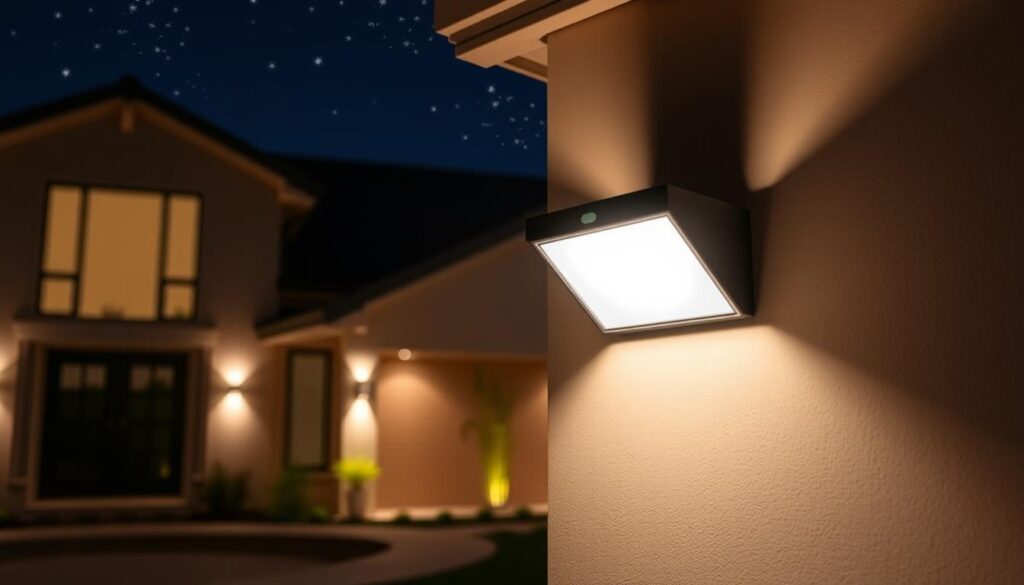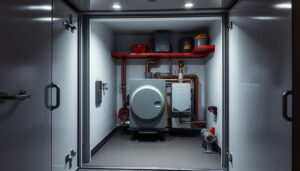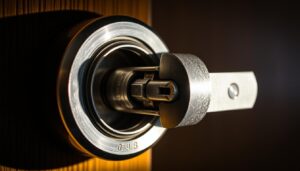Are you tired of stumbling in the dark or worrying about intruders lurking in the shadows around your home? You’re not alone. Many homeowners in the UK are turning to motion sensor outdoor lights to enhance their property’s security and convenience.
These innovative lights combine energy efficiency with advanced sensor technology, illuminating areas only when needed. By detecting motion, they provide a reliable and cost-effective solution for outdoor lighting.
As you explore the world of motion sensor technology, you’ll discover a range of options designed to suit different needs and preferences. Our comprehensive guide will walk you through the benefits, types, and installation of these sensor lights, helping you make an informed decision to brighten up your outdoor space.
Key Takeaways
- Motion sensor outdoor lights enhance home security and convenience.
- They offer energy efficiency by illuminating areas only when needed.
- Advanced sensor technology detects motion to activate the light.
- A range of motion sensor lights are available to suit different needs.
- Our guide covers the benefits, types, and installation of sensor lights.
Benefits of Motion Sensor Outdoor Lights
Motion sensor outdoor lights offer numerous benefits for homeowners, enhancing both security and convenience. These benefits can be broken down into several key areas.
Enhanced Security Features
Motion sensor lights serve as a powerful deterrent against potential intruders by suddenly illuminating dark areas when motion is detected. This enhanced security feature can significantly reduce the risk of criminal activity around your home.
Energy Efficiency and Cost Savings
Motion-activated lights are highly energy-efficient as they only illuminate when needed, reducing electricity consumption by up to 75% compared to traditional lighting. This leads to significant cost savings on your electricity bills over time.
Convenience and Accessibility
Motion sensor lights provide hands-free illumination, making it easier to navigate outdoor spaces in darkness. They also improve accessibility for elderly or disabled individuals by automatically illuminating pathways.
- Reduce energy consumption and lower your carbon footprint
- Enhance security by deterring potential intruders
- Improve accessibility and convenience for homeowners
How Motion Sensor Lights Work
Understanding how motion sensor lights work involves exploring the technology behind motion detection and its application in lighting systems. Motion sensor lights are designed to detect changes in their surroundings, such as the presence of moving objects or changes in temperature, and then trigger the illumination of a light source.
Types of Motion Sensors
There are several types of motion sensors, including passive infrared (PIR), ultrasonic, and microwave sensors, each with different motion detection methods. PIR sensors detect body heat and movement, making them ideal for outdoor security applications. Ultrasonic sensors emit sound waves to detect movement, often used in indoor settings. Microwave sensors use radio waves to detect motion through certain materials, offering greater range.
Detection Range and Sensitivity
The detection range of motion sensors varies, with basic models covering 10-15 feet and advanced sensors having ranges up to 70 feet. Sensitivity settings can be adjusted to prevent false triggers from small animals or moving plants. A comparison of detection ranges and sensitivity levels among different motion sensors is shown in the table below:
| Sensor Type | Detection Range | Sensitivity |
|---|---|---|
| PIR | 10-30 feet | Adjustable |
| Ultrasonic | 15-50 feet | High |
| Microwave | up to 70 feet | Very High |
Where to Place Motion Sensor Outdoor Lights
Strategically placing motion sensor lights around your home is essential for optimal performance. The right locations can enhance security and provide convenience. When deciding where to install these lights, consider areas that benefit from automated lighting.
Entry Points and Doorways
Positioning motion sensor lights at entry points such as front doors, back doors, and side entrances can deter intruders and provide welcome lighting for residents. This placement serves both security and convenience purposes.
Pathways and Walkways
Installing sensor lights along pathways and walkways can prevent trips and falls by illuminating the way. This is particularly useful in areas with heavy foot traffic or where visibility is poor at night.
Driveways and Garages
Motion sensor outdoor lights placed near driveways and garages can assist with vehicle parking and deter potential car-related crimes by illuminating the area.
Backyards and Gardens
Placing motion sensor lights in backyards and gardens can protect recreational areas and detect wildlife intrusions, enhancing overall security around your home.
Tools and Materials Needed to Install Motion Sensor Outdoor Lights
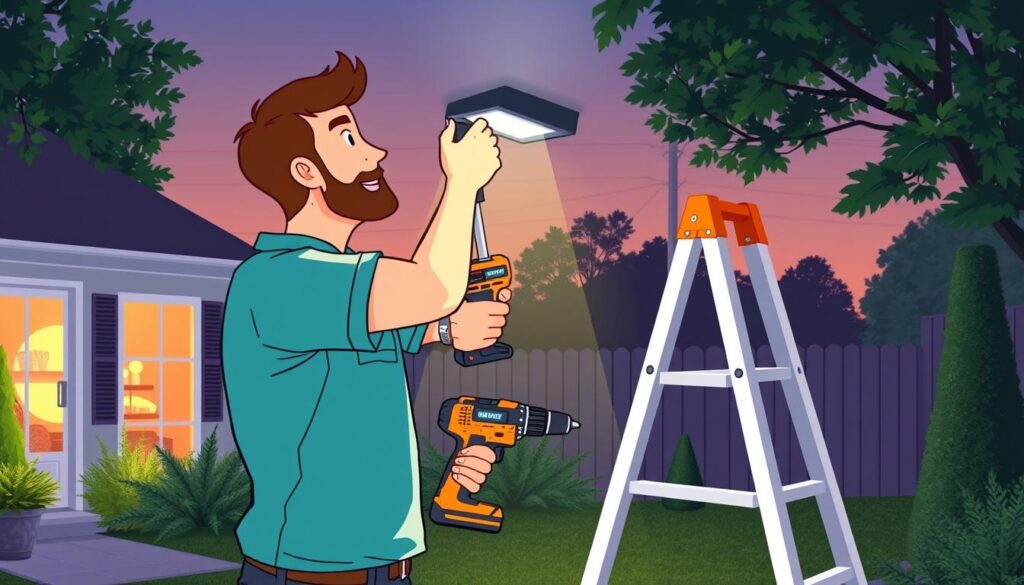
The installation of motion sensor outdoor lights requires careful preparation, starting with the right tools and materials. To ensure a smooth and safe installation process, it’s essential to gather everything you need beforehand.
Essential Tools for Installation
For a successful installation, you’ll need a set of basic hand tools, including a screwdriver (both flathead and Phillips), pliers, wire strippers, and a voltage tester. Safety equipment such as gloves, safety glasses, and appropriate footwear are also crucial. A non-contact voltage tester is particularly important for ensuring your safety while working with electrical systems.
Required Materials and Components
The materials needed include the motion sensor light fixture, wire connectors, electrical tape, weatherproof sealant, and mounting hardware. If you’re installing a new fixture, you’ll also need to select an appropriate junction box. It’s advisable to check the product box for any additional tools or accessories provided by the manufacturer.
Safety Precautions Before Installation
Before installing motion sensor outdoor lights, it’s crucial to consider several safety precautions to avoid electrical accidents and ensure a smooth installation process.
Electrical Safety Measures
To prevent electrical shocks, you must take certain precautions. First, shut off the power at the circuit breaker before starting any electrical work. Use a voltage tester to confirm that the power is completely off before touching any wires. Properly handle electrical wires by identifying hot, neutral, and ground wires. Wear insulated gloves and safety glasses to protect yourself from potential electrical hazards.
- Ensure the motion sensor light is compatible with your existing wiring.
- Avoid overloading circuits, as this can lead to serious electrical issues.
Working at Height Considerations
When installing motion sensor lights at heights, use a ladder safely by following the 4:1 ratio rule and ensuring a stable footing. Avoid installing lights during rain or high winds, as these conditions can significantly increase the risk of accidents. If you’re unsure about any aspect of the installation, consider hiring a professional electrician to ensure your safety.
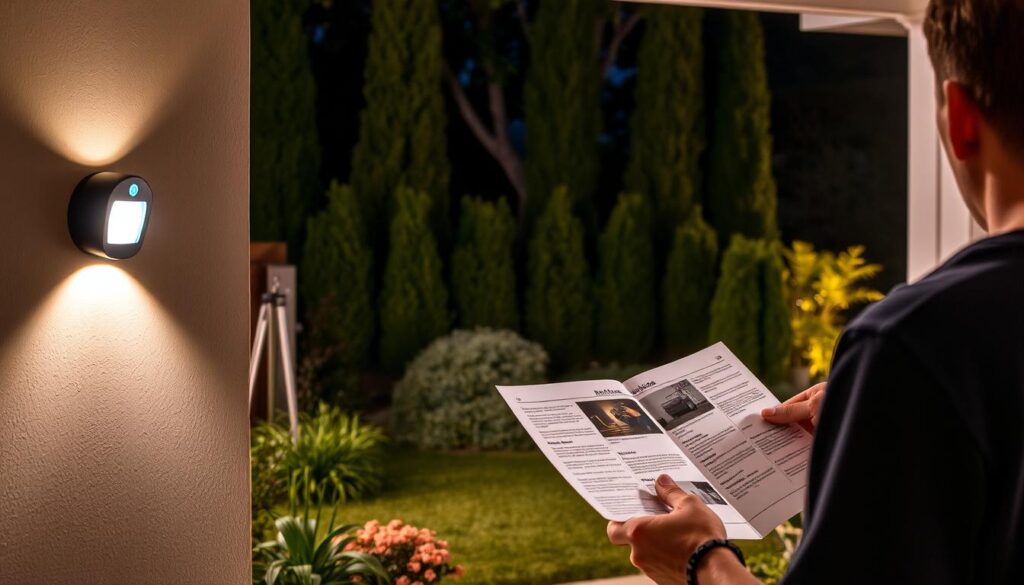
How to Install Motion Sensor Outdoor Lights: Step-by-Step Guide
Installing motion sensor outdoor lights can significantly enhance your home’s security and convenience. This guide will walk you through the installation process, ensuring you can do it safely and effectively.
Step 1: Shut Off the Electricity
Before starting, ensure your safety by shutting off the electricity to the existing light fixture or the circuit you’ll be working on. You may need to flip the breaker in your electrical panel. Use a circuit tester to confirm that no electricity flows to the wires.
Step 2: Remove Existing Fixture
If you’re replacing an existing light fixture, remove the old one by unscrewing or unclipping it from its mounting bracket. Once removed, disconnect the wires by unscrewing the wire nuts and separating the wires.
Step 3: Install the New Fixture Base
Most motion sensor lights come with a mounting bracket or base. Secure this new base to the electric box on your wall or ceiling with the provided screws.
Step 4: Connect the Wiring
Connect the wires from the motion sensor light to the wires from your electrical box. Typically, these connections include black-to-black (hot), white-to-white (neutral), and green or bare copper to the ground wire. Use wire connectors to secure these connections and wrap them with electrical tape.
Step 5: Mount the Light and Seal
Attach the light to the mounting bracket using the provided screws. Ensure it is firmly in place. Check the base of the junction box and seal any openings around the fixture using outdoor-rated silicone caulk to prevent water ingress.
Step 6: Test the Installation
Finally, conduct a final test to ensure your light works as intended. Walk through the detection zone to see if it lights up, confirming that the motion sensor is functioning correctly.
Adjusting Motion Sensor Light Settings
After installing your motion sensor outdoor lights, fine-tuning the settings is crucial for optimal performance. Most motion sensor lights come with adjustable settings such as motion zone, sensitivity, duration, and range.
Setting the Motion Zone and Range
Adjusting the motion detection zone ensures that the lights cover specific areas without triggering false alarms. To do this, you can typically adjust the sensor’s angle and range. For instance, if you want to illuminate a pathway, you can narrow the detection zone to focus on that area.
Adjusting Sensitivity Levels
The sensitivity adjustment dial allows you to calibrate the sensor for different environmental conditions. For example, in areas with a lot of foliage, you may need to reduce the sensitivity to avoid false triggers caused by leaves or branches moving in the wind.
Setting Time Delay and Light Duration
You can also adjust the time delay, which determines how long the lights remain on after motion stops. Additionally, some models offer dusk-to-dawn settings, allowing you to program the lights to activate only during nighttime hours.
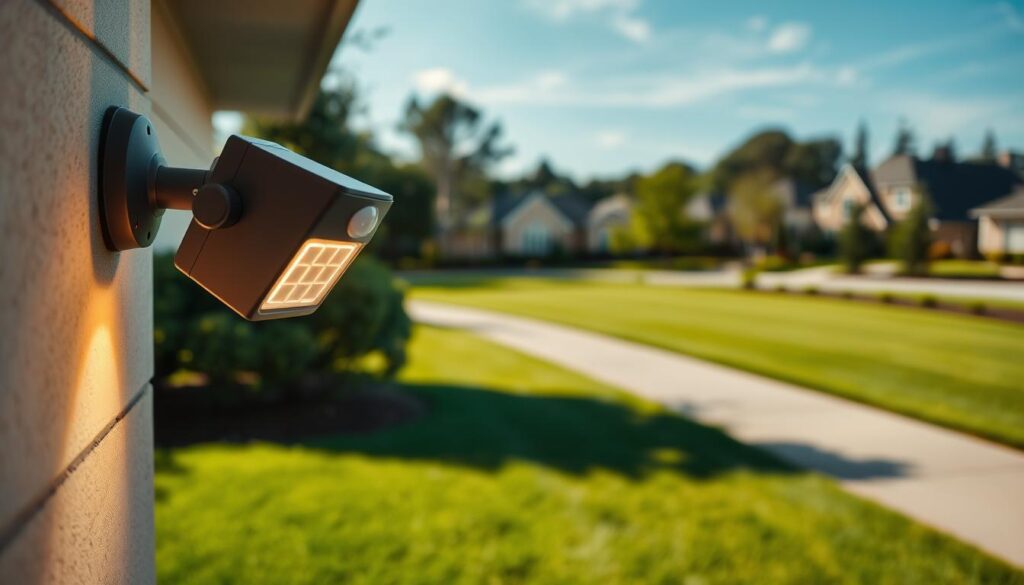
- Adjust the motion zone to cover specific areas.
- Calibrate sensitivity levels for environmental conditions.
- Set appropriate time delays and light durations.
Adding Motion Sensors to Existing Outdoor Lights
You can easily upgrade your outdoor lighting system by integrating motion sensors, providing an added layer of safety and energy efficiency. This guide will walk you through the process of retrofitting your existing outdoor lights with motion sensor technology.
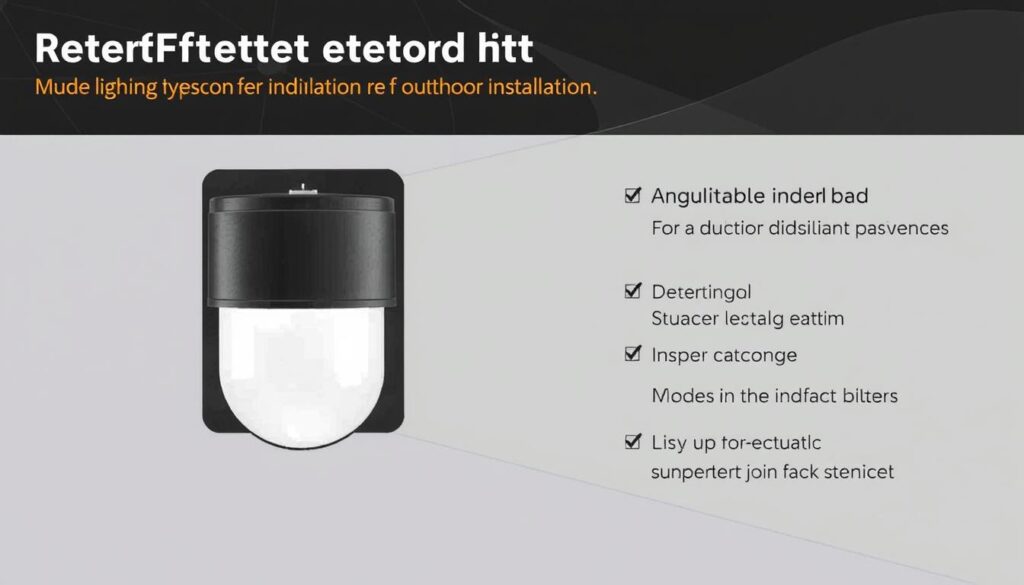
Compatibility Considerations
Before purchasing a motion sensor, ensure it is compatible with your existing light fixtures. Check the sensor’s communication protocol to ensure it matches your smart lighting system, if applicable. Common protocols include Zigbee, Z-Wave, WiFi, and Bluetooth.
Installation Process for Retrofit Sensors
The installation process involves selecting the right motion sensor and connecting it to your existing lights. You can choose between battery-powered sensors or those requiring a wired connection. For a wired connection, you’ll need to work with the existing wiring and possibly install a new wire to the box controlling your outdoor lights. For detailed steps, you can refer to guides on how to add a motion sensor to existing outdoor.
DIY vs Professional Installation: Costs and Considerations
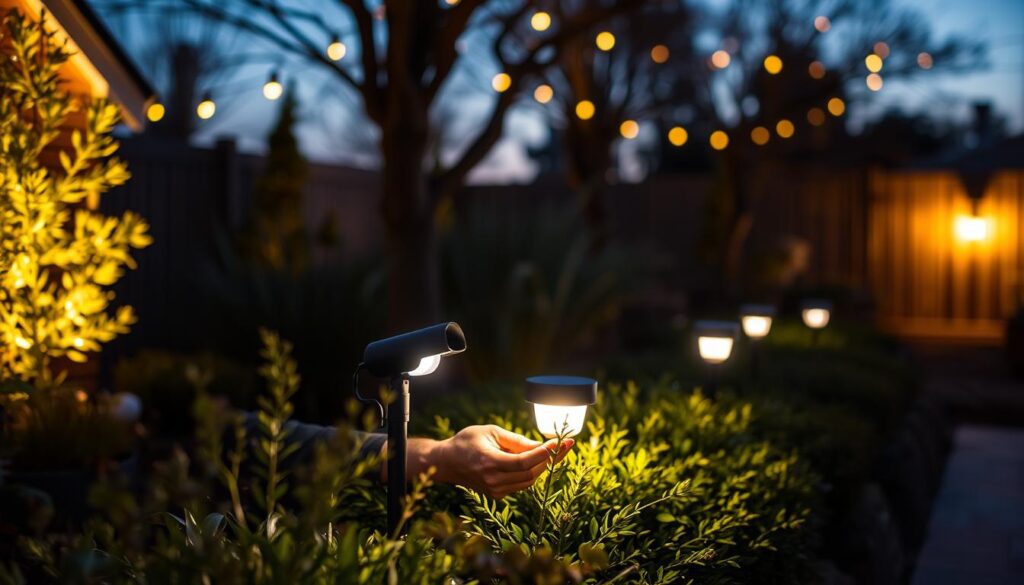
The decision to install motion sensor outdoor lights yourself or hire a professional depends on several factors, including your comfort with DIY projects and the complexity of the installation.
DIY Installation Costs
When opting for a DIY installation, the primary costs include the motion sensor lights themselves and any additional tools or materials required. Basic outdoor motion sensor lights can start at around £20 to £50 each, while more advanced and smart sensor lights can range from £50 to £200 or more per fixture.
You should also consider potential hidden costs, such as correcting mistakes or purchasing specialised tools, which can add to the overall cost of your DIY project.
Professional Installation Services
Hiring a professional electrician ensures a safe and correct installation, especially for complex wiring situations or high installations. The average hourly rate for a professional electrician can range from £40 to £120 per hour, depending on your location and the electrician’s expertise.
When to Call an Electrician
If you’re unsure about any aspect of the installation, such as dealing with existing wiring or installing lights at heights, it’s advisable to call a professional. They can provide a safe and efficient installation, giving you peace of mind.
Conclusion
Motion sensor outdoor lights offer a multifaceted approach to home security, combining energy efficiency with enhanced safety features. By understanding the benefits and types of motion sensor lights, you can make an informed decision about their installation. Proper placement and electrical safety are crucial during the installation process. These lights not only provide significant energy and cost savings compared to traditional outdoor lighting but also form an important part of a comprehensive home security strategy.
As you assess your specific needs, consider whether DIY or professional installation is best for you. The future of motion sensor lighting technology holds exciting possibilities, including smart home integration. By installing motion sensor outdoor lights, you can enjoy enhanced security and everyday convenience, making them a valuable addition to your home.
